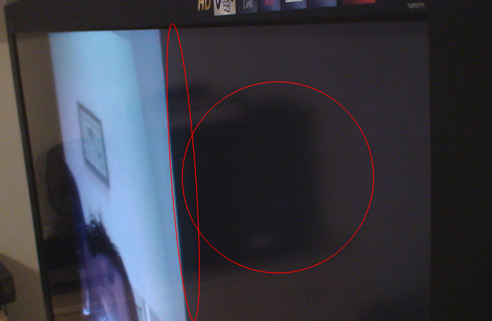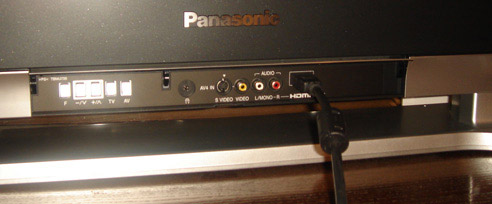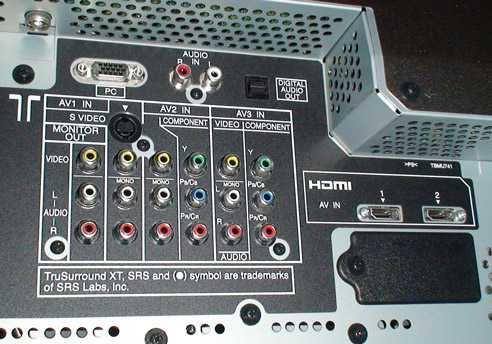Introduction
Panasonic's new 50PV700 (TH-50PZ700U in the US) Viera series plasma is one of a new batch of
50" 1080p plasmas coming from Japan's Mitushita
corporation.
Panasonic has made a few interesting choices
with these models, including a very high contrast ratio, SD memory card support, and CI slot.
The Design
The outer display bezel is black
and sleek, but not shiny, bordered by two aluminum strips above and below
the screen. The lower strip is wider and hosts the On/Off button, as well as
hiding a panel (holding control buttons, a headset plug, S-Video/composite
and HDMI inputs – mostly useful for HDV video cameras) and the well designed
luminescent SD card slot.
Whereas plasma panels traditionally use a
shiny glass display, LCD panels usually have a defused softer front. The
reasons for this are technical – plasmas need a hard clear
frontal surface and glass was a natural solution. LCD's diffusion of light
often gave the viewer the appearance that it handled light reflections
better, and so was less affected by ambient lighting. In a way, this was
true – softer ambient lighting reflected from the entire surface, while
plasmas often produced a mirror effect that caused the entire room to be
reflected to some degree back onto the viewer.
So, here is an interesting turn of events – the 700 Viera
series is the first to use a diffused front surface to significantly reduce light
reflection (ironic, since companies like Samsung have changed their high end LCDs
to be "shiny" and look more like a Plasma all the time). The effect is someone
LCD-esque. Undoubtedly this is what Panasonic intended – blur the
technologies and let customers choose the product based on how it looks and
not by what their friends might have said. While this will have a more
significant impact on the viewer in a TV store, it took
a while for me to get used to this in my home. The shine from the display
had a calming impact on me before, and I missed it now. See the following
link:
http://panasonic.net/think_plasma/
While the outer filter has been changed,
looking at the image from the side, while using a window IRE test pattern,
it was easy to see that the same type of internal glass/air filter was
still in use. These cause a repeating image to be seen when viewed from a
particularly acute angle, indicating that Panasonic still has some
catching up to do in this respect.
This
image below attempts (it's hard to pass the full effect through a digital camera)
to show these items:
-
The bigger circle outlines how an object
would appear when reflecting off the new 700 series filter.
-
The long oval shows a brighter area "double
image" as light reflects internally from an internal glass/air filter
and bounces out. This is hard to see under normal conditions.

The two sides of the panel hide two invisible
ultra slim speakers, mostly suitable for smaller rooms and "talking heads"
style shows (news, talk shows, etc.), but are not as effective for music or
movies. Apparently, the entire bulk of the chassis serves as the resonance
area for twin passive subwoofers within the set.
Front panel inputs are shown below.

The
back panel of the display provides quite a few inputs for the display: One PC
VGA input (with two RCA audio inputs), twin composite inputs, an S-Video input,
two component inputs, and two HDMI inputs. Each S-Video or component input
also has a composite input, so the set can actually accept a maximum of four
composite inputs, two S-Video inputs, and two component inputs – but not at the
same time. The unit also decodes HDMI audio and provides a digital (optical)
audio output, as well as monitor out, consisting of stereo RCA audio outputs and a monitor video out (not really sure who would
need to use that).

This model lacks an HDMI 1.3a input, which is
a bit disappointing, but also not really as useful for displays as it would
be on a receiver (unless you consider Deep Color/XVYCC support critical).
An RF input coupled with the optional CI input
will mostly be useful for Europeans needing DVB-T support or for DTV support
in the US market.
Go to Part II.